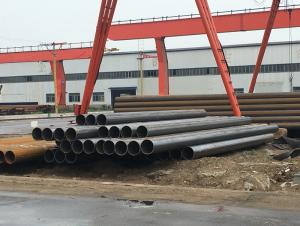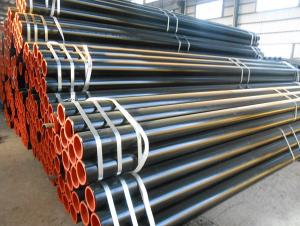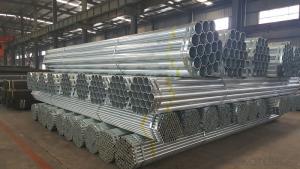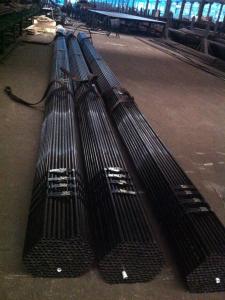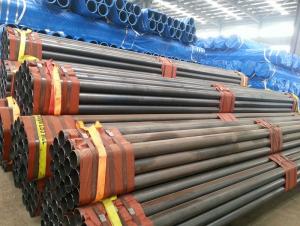Conveying low pressure fluid seamless steel pipe
- Loading Port:
- Tianjin
- Payment Terms:
- TT or LC
- Min Order Qty:
- 100 m.t.
- Supply Capability:
- 20000 m.t./month
OKorder Service Pledge
OKorder Financial Service
You Might Also Like
1、Structure of Conveying low pressure fluid seamless steel:
Seamless pipe is formed by drawing a solid billet over a piercing rod to create the hollow shell. As the manufacturing process does not include any welding, seamless pipes are perceived to be stronger and more reliable. Historically seamless pipe was regarded as withstanding pressure better than other types, and was often more easily available than welded pipe.
2、Main Features of Conveying low pressure fluid seamless steel:
• High manufacturing accuracy
• High strength
• Small inertia resistance
• Strong heat dissipation ability
• Good visual effect
• Reasonable price
3、 Conveying low pressure fluid seamless steel Specification:
Standard | GB, DIN, ASTM ASTM A106-2006, ASTM A53-2007 |
Grade | 10#-45#, 16Mn 10#, 20#, 45#, 16Mn |
Thickness | 8 - 33 mm |
Section Shape | Round |
Outer Diameter | 133 - 219 mm |
Place of Origin | Shandong, China (Mainland) |
Secondary Or Not | Non-secondary |
Application | Hydraulic Pipe |
Technique | Cold Drawn |
Certification | API |
Surface Treatment | factory state or painted black |
Special Pipe | API Pipe |
Alloy Or Not | Non-alloy |
Length | 5-12M |
Outer Diameter | 21.3-610mm |
Grade | 20#, 45#, Q345, API J55, API K55, API L80, API N80, API P110, A53B |
Standard | ASME, ASTM |
1) Material:20#(ASTM A 106/A53 GRB.API5LGRB,GB),45#,16Mn,10#.
2) Specification range:OD:21.3-610mm,WT:6-70mm,length:6-12m or according to the requirement of clients.
3) Excutive standards:GB,ASME API5L.ASTM A 106/A53,Despite of the above standards,we can also supply seamless steel pipe with standard of DIN,JIS,and so on,and also develop new products according to the requirements of our clients!
4) Surface:black lacquered,varnish coating or galvanized.
5) Ends:Beveled or square cut,plastic capped,painted.
6) Packing:bundles wrapped with strong steel strip,seaworthy packing.
4、Packaging & Delivery
Packaging Details: | seaworthy package,bundles wrapped with strong steel strip |
Delivery Detail: | 15-30days after received 30%TT |
5、FAQ of Conveying low pressure fluid seamless steel:
①How is the quality of your products?
Our products are manufactured strictly according to national and internaional standard, and we take a test
on every pipe before delivered out. If you want see our quality certifications and all kinds of testing report, please just ask us for it.
Guaranteed: If products’ quality don’t accord to discription as we give or the promise before you place order, we promise 100% refund.
②How about price?
Yes, we are factory and be able to give you lowest price below market one, and we have a policy that “ for saving time and absolutely honest business attitude, we quote as lowest as possible for any customer, and discount can be given according to quantity”,if you like bargain and factory price is not low enough as you think, just don’t waste your time.Please trust the quotation we would give you, it is professional one.
③Why should you chose us?
Chose happens because of quality, then price, We can give you both.Additionally, we can also offer professional products inquiry, products knowledge train(for agents), smooth goods delivery, exellent customer solution proposals.Our service formula: good quality+good price+good service=customer’s trust
SGS test is available, customer inspection before shipping is welcome, third party inspection is no problem.
6、 Conveying low pressure fluid seamless steel Images:
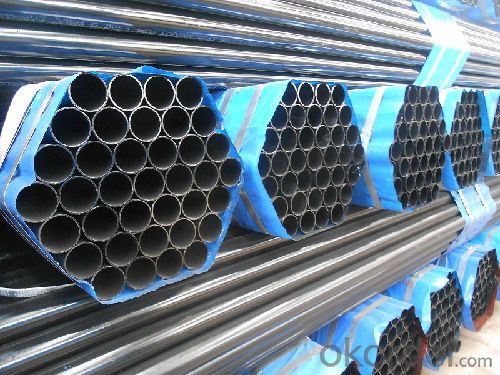
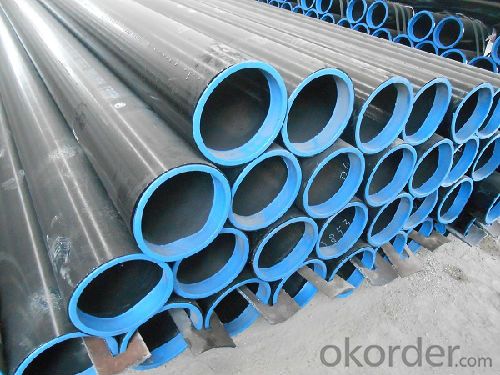
- Q: How are steel pipes used in the construction of desalination plants?
- Steel pipes are used in the construction of desalination plants for various purposes such as transporting seawater, brine, and treated water, as well as for structural support in the plant's infrastructure. These pipes are durable, corrosion-resistant, and capable of withstanding high-pressure conditions, making them ideal for the harsh and corrosive environment of desalination plants.
- Q: How are steel pipes protected against mechanical damage during transportation?
- Steel pipes are protected against mechanical damage during transportation through various methods such as using protective coatings, wrapping them with foam or other cushioning materials, securing them with straps or bands, and using appropriate packaging techniques to minimize impact and vibration.
- Q: Will the steel tube dance?
- In a single pole dance performance, the dancer moves more naturally, herself, moves and techniques, and does what she wants to do, while the style of dance is determined by herself, no one intervenes, and quite free.
- Q: How are steel pipes protected during transportation and storage?
- Steel pipes are usually protected during transportation and storage through various measures such as coating them with anti-corrosion materials, wrapping them with protective films or tapes, using wooden crates or pallets for stacking and securing them with straps or bands. Additionally, pipes are often stored in covered or climate-controlled warehouses to prevent exposure to moisture and other potential damaging elements.
- Q: Are steel pipes suitable for underground drainage systems?
- Yes, steel pipes are suitable for underground drainage systems. Steel pipes have several qualities that make them a popular choice for underground drainage. Firstly, steel pipes are strong and durable, capable of withstanding high pressure and heavy loads. They are resistant to corrosion and can last for many years without the need for frequent maintenance or replacement. Steel pipes also have the advantage of being versatile and adaptable to different soil conditions. They can be easily customized to fit the specific needs of the drainage system, including varying diameters and lengths. Additionally, steel pipes can be welded together, ensuring a tight and secure connection that prevents leakage and the infiltration of groundwater. Another benefit of steel pipes in underground drainage systems is their ability to handle a wide range of temperatures. They are resistant to extreme heat or cold, making them suitable for various climates and environments. However, it is important to note that steel pipes can be more expensive than alternative materials like PVC or HDPE pipes. Additionally, they can be heavier and more difficult to install, requiring specialized equipment and expertise. Overall, steel pipes are a reliable and long-lasting option for underground drainage systems, particularly in areas where durability and strength are important considerations.
- Q: What are the quality control measures for steel pipe manufacturing?
- The quality control measures for steel pipe manufacturing typically include various stages of inspection and testing, starting from raw material evaluation to the final product. These measures may include checking the chemical composition and mechanical properties of the steel, conducting non-destructive testing such as ultrasonic or magnetic particle inspection, monitoring the dimensions and surface finish of the pipes, and ensuring compliance with relevant industry standards and specifications. Additionally, quality control measures may involve regular maintenance and calibration of equipment, rigorous documentation and traceability of processes, and continuous monitoring and improvement of manufacturing techniques to meet the desired quality standards.
- Q: What are the advantages of using steel pipes?
- There are several advantages of using steel pipes. Firstly, steel pipes are extremely durable and have a long lifespan, making them a cost-effective choice for various applications. Secondly, steel pipes have high resistance to corrosion, making them suitable for use in harsh environments and underground applications. Thirdly, steel pipes have high strength and can withstand heavy loads, making them ideal for transporting fluids and gases under high pressure. Additionally, steel pipes are versatile and can be easily welded, threaded, or bent to fit specific requirements. Lastly, steel pipes are recyclable, making them an environmentally friendly choice.
- Q: What place must use galvanized steel pipe to make lighting line?
- Galvanized pipe for pipeline laying construction and transformation of lighting, power, telephone, fire protection system in the engineering (made of galvanized steel), for laying, laying can be laid in the dark, the wall can also be installed on the ceiling.
- Q: How are steel pipes repaired in case of damage?
- Steel pipes are repaired in case of damage through various methods such as welding, patching, or replacing the damaged section. The appropriate repair technique depends on the type and extent of the damage to ensure the structural integrity and functionality of the pipe.
- Q: How do you prevent steel pipes from freezing?
- One way to prevent steel pipes from freezing is to insulate them with pipe insulation or heat tape. Additionally, keeping the area around the pipes well-heated and ensuring proper ventilation can help prevent freezing.
Send your message to us
Conveying low pressure fluid seamless steel pipe
- Loading Port:
- Tianjin
- Payment Terms:
- TT or LC
- Min Order Qty:
- 100 m.t.
- Supply Capability:
- 20000 m.t./month
OKorder Service Pledge
OKorder Financial Service
Similar products
Hot products
Hot Searches
Related keywords













